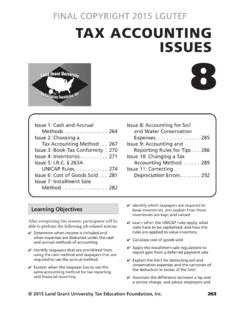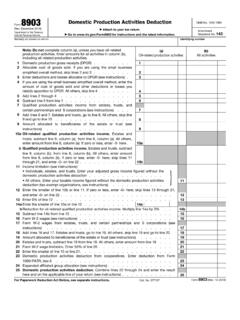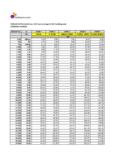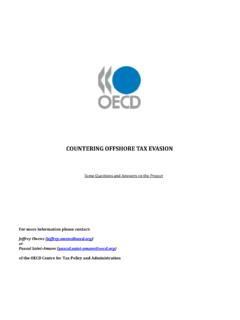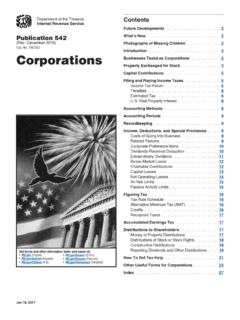Transcription of PRODUCTION DEDUCTION 13 - Tax Workbook
1 2006 Land Grant University Tax Education Foundation, to repeal by the American Jobs CreationAct of 2004, the 114 extraterritorialincome (ETI) exclusion allowed taxpayers toexclude qualifying foreign trade income fromtheir gross income. Qualifying foreign tradeincome was determined by taking the greatest ofthree computed amounts based on foreign trad-ing gross receipts, foreign trade income, and for-eign sale and leasing repeal is effective for transactions afterDecember 31, 2004, with two can claim 80% of the exclusion in2005 and 60% of the exclusion in for all chapters and the 2006 National Income Tax Workbook Update are available at (User Name: class2006 Password: class2006).
2 BACKGROUNDO verview of the DPAD 466 QPAI469 DPGR469 Allocating Costs472 Form W-2 Wages474 Selected PRODUCTION Activities475 Partnerships and S Corporations 478 Share-Rent Arrangements487 Land Owned by an LLC 488 Patrons of Cooperatives 489 Alternative Minimum Tax 490 Net Operating Losses 491466 OVERVIEW OF THE DPADFINAL repeal does not affect the exclusion forincome attributable to transactions that weresubject to a binding contract that was in effecton September 17, ETI exclusion was repealed because itviolated World Trade Organization agreementsthat prohibit countries from subsidizing ETI exclusion was preceded by the foreignsales corporation (FSC) provisions and thedomestic international sales corporation (DISC)provisions, which were also held to be in viola-tion of World Trade Organization wanted to replace some of the taxbenefits of the ETI exclusion and provide anincentive for producers to hire workers inthe United States.
3 However, it had to providethose incentives in a way that did not violate theWorld Trade Organization agreements. Theresult was new 199. Created by the 2004 Jobs Act, it allows certain taxpayers to claim adeduction for a percentage of their net incomefrom qualified domestic PRODUCTION activities. Ineffect, it gives a tax break for certain kinds of pro-duction activities carried on in the United States,but only if there are employees working in theUnited 199 was amended by the Gulf Oppor-tunity Zone Act of 2005 ( 109-135) and theTax Increase Prevention and Reconciliation Actof 2005 ( 109-222).
4 Final regulations ( ) were published on May 24, 2006, replacingthe earlier proposed regulations and Notice 2005-14, 2005-1 CB 498, effective for tax years begin-ning on or after June 1, 2006. Methods for deter-mining wages are set out in Rev. Proc. 2006-22,2006-22 IRB 1033, which was also published onMay 24, 2006. The methods are included in a rev-enue procedure rather than in the final regula-tions, so that if changes are made to Form W-2,Wage and Tax Statement, a new revenue proce-dure can be issued reflecting those changes morepromptly than an amendment could be made tothe final regulations.
5 The domestic PRODUCTION activities DEDUCTION (DPAD) may provide a significant tax benefit fortaxpayers who can take advantage of its provi-sions. The provisions are complex and willrequire new bookkeeping procedures for sometaxpayers. Some taxpayers may need to restruc-ture their business arrangements to take fulladvantage of the income tax DEDUCTION is limited to employ-ers with PRODUCTION activities within theUnited States. For taxable years beginning in2005 and 2006, the domestic PRODUCTION activi-ties DEDUCTION (DPAD) equals the smallest of thefollowing three of taxable income derived from a quali-fied PRODUCTION activity (QPAI) of adjusted gross income (AGI) for the taxyear (taxable income for corporations)
6 Of the Form W-2 wages paid by the tax-payer during the calendar year that ends inthe tax yearBoth of the 3% DPAD limits increase to 6%for taxable years beginning in 2007, 2008, and2009, and to 9% for taxable years beginning after2009. Therefore, taxpayers have some time toorganize their business activities in a way thatmaximizes the benefit of the DPAD when it isfully phased service activities do not qualify forthe DPAD. If a taxpayer is engaged exclusivelyin the PRODUCTION of qualified property within theUnited States and has no other sources of income,qualified PRODUCTION activity taxable income islikely to equal overall taxable 199(d)(5) provides that 199 isapplied by taking into account only items that areattributable to the actual conduct of a trade orbusiness.
7 The abbreviations used in this chapter arealso used in the regulations and other guidancefrom the IRS, as well as in articles about theDPAD. To help readers keep track of these acro-nyms, they are listed in Figure OF THE DPADC omputing the DPAD46713 FINAL LGUTEFT axpayers compute their DPAD on Form 8903, domestic PRODUCTION Activities DEDUCTION . Indi-viduals include their share of the DPAD frompass-through entities, such as partnerships, LLCstaxed as partnerships, and S corporations, as wellas from proprietorships.
8 Members of agriculturalcooperatives also include the DPAD for their dis-tributions from the taxpayers claim the DEDUCTION asan adjustment to income on line 35 of Form 1040, Individual Income Tax Return. C corpora-tions claim the DPAD on line 25 of Form 1120, Corporation Income Tax Return, or line 21of Form 1120-A, Corporation Short-FormIncome Tax Return. Estates and trusts are eligiblefor the DPAD if the income is not passed throughto the DPAD is the least of three amounts,all taxpayers have to compute the base figure forthose amounts to determine their 8903 applies the rules by first compar-ing QPAI with the taxpayer s AGI (taxableincome for corporations) and applying the3% rate (for 2005 and 2006)
9 To the lesser ofthe 8903 then compares the above resultfrom 1 above with 50% of the Form W-2wages and instructs the taxpayer to claim thelesser of these two figures as the 8903 then adds to the result from 2above any DPAD passed through to the tax-payer from a get an overview of the DPAD, the follow-ing example presents a set of facts that assumes anunderstanding of terms and concepts that areused in 199 and the regulations and IRSguidance for 199. Those terms and con-cepts are explained later in this Form 8903 Joan Juniper operates a sole proprietorship.
10 In2006 she did not elect to use either of the simpli-fied methods of allocating expenses. From herrecords, she computed the amounts for the itemsshown in Figure Joan was a member of an LLC that is taxed asa partnership. It reported $35,000 as her share ofQPAI and $2,000 as her share of wages. Joan wasalso a member of an agricultural cooperative thatreported $600 as her share of the cooperative sDPAD. Joan s adjusted gross income for 2006was $70,000. The calculation of her $2,550 DPAD is shown on Form 8903 in Figure List of AcronymsAbbreviationTermDPADD omestic PRODUCTION activities DEDUCTION QPAIQ ualified PRODUCTION activities incomeDPGRD omestic PRODUCTION gross receiptsnon-DPGRG ross receipts other than DPGRCGSCost of goods soldQPPQ ualifying PRODUCTION propertyMPGEM anufactured, produced, grown, or extractedEAGE xpanded affiliated groupForm 8903 Computing the DPADFIGURE Joan s Sole ProprietorshipItemAmountDomestic PRODUCTION gross receipts (DPGR)
